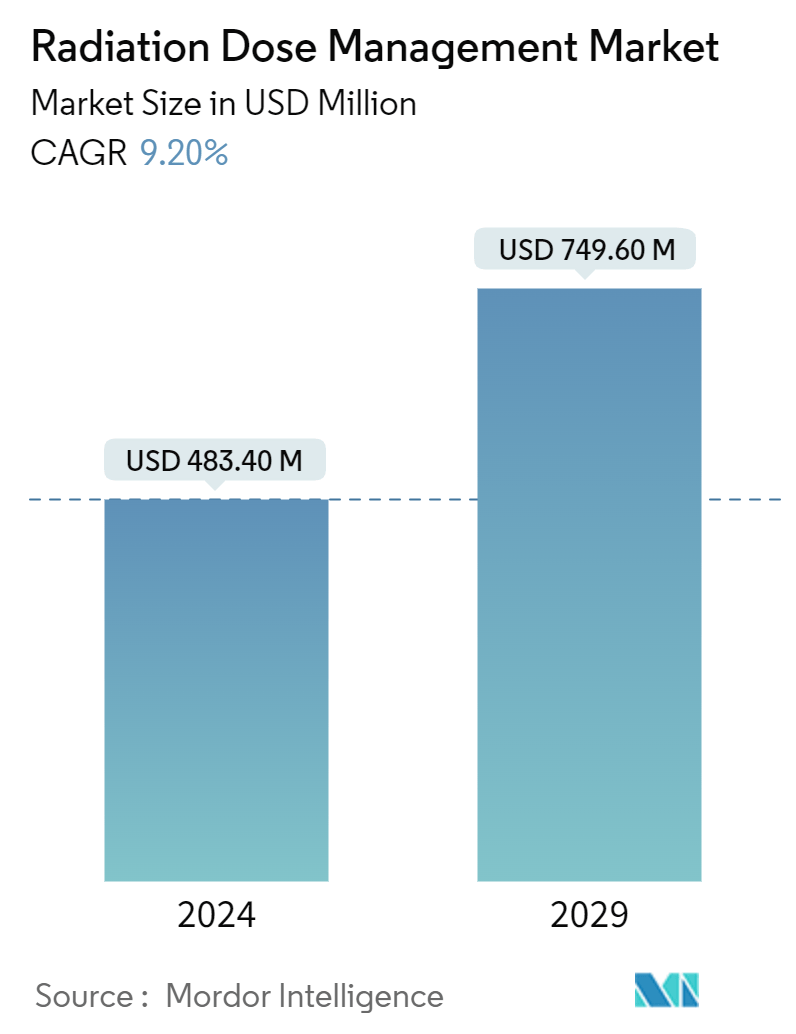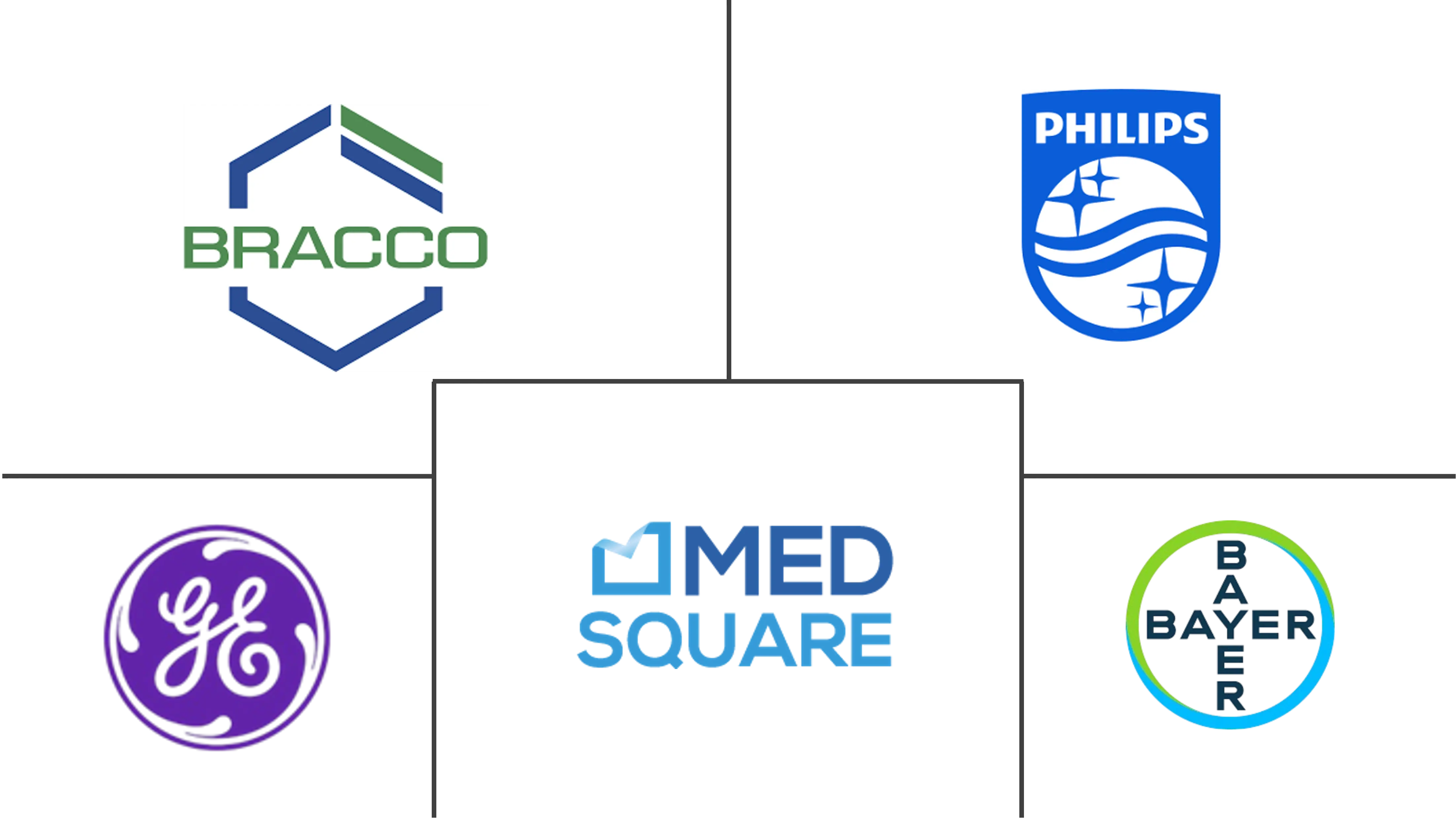Market Size of Radiation Dose Management Industry

| Study Period | 2019 - 2029 |
| Market Size (2024) | USD 483.40 Million |
| Market Size (2029) | USD 749.60 Million |
| CAGR (2024 - 2029) | 9.20 % |
| Fastest Growing Market | Asia Pacific |
| Largest Market | North America |
Major Players
*Disclaimer: Major Players sorted in no particular order |
Radiation Dose Management Market Analysis
The Radiation Dose Management Market size is estimated at USD 483.40 million in 2024, and is expected to reach USD 749.60 million by 2029, growing at a CAGR of 9.20% during the forecast period (2024-2029).
- Radiation dose management has emerged as a pivotal aspect of modern healthcare, driven by the expanding use of diagnostic imaging and radiation therapy, particularly for chronic disease management. This market focuses on the critical need to monitor and control radiation exposure for patients, healthcare professionals, and the environment. It includes a broad spectrum of products and services such as dose tracking systems, radiation protection solutions, and compliance software, all of which are essential to ensuring the safety and efficacy of radiation-based medical procedures.
Chronic Diseases Driving Demand for Radiation Therapy
- Increased Need for Radiation Therapy: The global surge in chronic diseases, especially cancer, has amplified the demand for radiation therapy, necessitating robust radiation dose management solutions. These solutions are crucial in delivering the minimum effective radiation dose, thereby mitigating potential harmful side effects.
- CT and Nuclear Medicine: Imaging modalities like computed tomography (CT) and nuclear medicine, heavily used in diagnosing and treating chronic conditions, require precise radiation dose monitoring. This requirement is driving the widespread adoption of sophisticated dose tracking systems across healthcare facilities.
- Aging Population Influence: The aging global population, prone to chronic diseases, further escalates the need for radiation therapy, thereby increasing the demand for dose management solutions. Healthcare providers are increasingly focusing on optimizing radiation doses to minimize risks while maintaining diagnostic accuracy.
- Technological Integration: The integration of advanced technologies in dose management systems is essential for meeting industry standards and improving patient outcomes. This includes innovations in dose reduction techniques and the incorporation of dose management software into hospital and radiology information systems.
Growing Awareness of Radiation Overexposure Risks
- Rising Concerns About Overexposure: The growing utilization of medical imaging and radiation therapy has heightened concerns about radiation overexposure. This has led to increased awareness among healthcare professionals, patients, and regulatory bodies about the risks associated with excessive radiation.
- Promotion of Radiation Safety: Industry initiatives and educational campaigns have played a significant role in promoting radiation safety and the adoption of dose reduction strategies. These efforts have led to the development and implementation of advanced radiation protection solutions, including sophisticated dose management software.
- Regulatory Guidelines: Stringent guidelines established by regulatory agencies, particularly in North America and Europe, are compelling healthcare facilities to invest in radiation dose management systems. These regulations aim to protect not only patients but also healthcare workers who are regularly exposed to radiation.
- Diverse Market Offerings: The market for radiation dose management solutions is diverse, with products tailored to different imaging modalities and healthcare settings. As the focus on radiation safety intensifies, the market is expected to evolve, with technological innovations playing a key role in enhancing the efficiency and effectiveness of dose management systems.
Radiation Dose Management Industry Segmentation
Radiation dose management solutions optimize and regulate the radiation dose during imaging procedures. They are used in hospitals, imaging centers, and research institutes to estimate the dose required for a procedure (e.g., CT scan) and prevent high radiation dose exposure to patients.
The radiation dose management market is segmented by products & services, modality, end user, and geography. By products & services, the market is segmented into standalone solutions, integrated solutions, and services. By modality, the market is segmented into computed tomography, fluoroscopy, interventional imaging, nuclear medicine radiography, and mammography. By end user, the market is segmented into ambulatory care settings, hospitals, and other end users. By geography, the market is segmented into North America, Europe, Asia-Pacific, the Middle East and Africa, and South America. The market report also covers the estimated market sizes and trends of 17 countries across major regions globally. The report offers the value (in USD) for the above segments.
| By Products & Services | |
| Standalone Solutions | |
| Integrated Solutions | |
| Services |
| By Modality | |
| Computed Tomography | |
| Fluoroscopy and Interventional Imaging | |
| Nuclear Medicine | |
| Radiography and Mammography |
| By End User | |
| Ambulatory Care Settings | |
| Hospital | |
| Other End Users |
| Geography | ||||||||
| ||||||||
| ||||||||
| ||||||||
| ||||||||
|
Radiation Dose Management Market Size Summary
The radiation dose management market is poised for significant growth, driven by increasing concerns over radiation overexposure and its long-term health consequences. Regulatory bodies like the United States FDA have mandated compliance with specific protocols to enhance patient safety during imaging procedures, such as CT scans. This has led to a surge in the adoption of advanced dose reduction technologies and systems in hospitals and imaging centers worldwide. These technologies, including dose tracking software and hardware-embedded solutions, are instrumental in minimizing manual dose collection efforts and improving dose estimation accuracy, thereby reducing the risk of radiation exposure. The market is further bolstered by the introduction of innovative CT equipment, such as Bayer’s Radimetric Enterprise Platform and Canon Medical Systems' Aquilion Precision System, which integrate advanced dose reduction features to enhance patient safety.
The market landscape is characterized by moderate competition, with global players like Bayer AG, Bracco Imaging S.P.A., GE Healthcare, and Koninklijke Philips N.V. leading the charge. These companies are at the forefront of technological advancements, while new entrants are focusing on product innovation to capture market share. The rising prevalence of chronic diseases, coupled with increased awareness and availability of advanced radiation dose management products, is expected to drive market expansion over the forecast period. Despite the challenges posed by high radiation exposure risks, the integration of state-of-the-art CT machines and software solutions in research centers and hospitals is facilitating accurate radiation dose estimation, contributing to the market's healthy growth trajectory.
Radiation Dose Management Market Size - Table of Contents
-
1. MARKET DYNAMICS
-
1.1 Market Overview
-
1.2 Market Drivers
-
1.2.1 Rising Cases of Chronic Diseases Demanding Radiation Therapy
-
1.2.2 Increasing Concerns over Radiation Overexposure
-
1.2.3 Rising Awareness and Industry Initiatives for Radiation Dose Management
-
-
1.3 Market Restraints
-
1.3.1 Low Adoption of radiation Dose Management Solutions in Emerging Countries
-
-
1.4 Porter's Five Force Analysis
-
1.4.1 Threat of New Entrants
-
1.4.2 Bargaining Power of Buyers/Consumers
-
1.4.3 Bargaining Power of Suppliers
-
1.4.4 Threat of Substitute Products
-
1.4.5 Intensity of Competitive Rivalry
-
-
-
2. MARKET SEGMENTATION (Market Size by Value - in USD)
-
2.1 By Products & Services
-
2.1.1 Standalone Solutions
-
2.1.2 Integrated Solutions
-
2.1.3 Services
-
-
2.2 By Modality
-
2.2.1 Computed Tomography
-
2.2.2 Fluoroscopy and Interventional Imaging
-
2.2.3 Nuclear Medicine
-
2.2.4 Radiography and Mammography
-
-
2.3 By End User
-
2.3.1 Ambulatory Care Settings
-
2.3.2 Hospital
-
2.3.3 Other End Users
-
-
2.4 Geography
-
2.4.1 North America
-
2.4.1.1 United States
-
2.4.1.2 Canada
-
2.4.1.3 Mexico
-
-
2.4.2 Europe
-
2.4.2.1 Germany
-
2.4.2.2 United Kingdom
-
2.4.2.3 France
-
2.4.2.4 Italy
-
2.4.2.5 Spain
-
2.4.2.6 Rest of Europe
-
-
2.4.3 Asia-Pacific
-
2.4.3.1 China
-
2.4.3.2 Japan
-
2.4.3.3 India
-
2.4.3.4 Australia
-
2.4.3.5 South Korea
-
2.4.3.6 Rest of Asia-Pacific
-
-
2.4.4 Middle-East and Africa
-
2.4.4.1 GCC
-
2.4.4.2 South Africa
-
2.4.4.3 Rest of Middle-East and Africa
-
-
2.4.5 South America
-
2.4.5.1 Brazil
-
2.4.5.2 Argentina
-
2.4.5.3 Rest of South America
-
-
-
Radiation Dose Management Market Size FAQs
How big is the Radiation Dose Management Market?
The Radiation Dose Management Market size is expected to reach USD 483.40 million in 2024 and grow at a CAGR of 9.20% to reach USD 749.60 million by 2029.
What is the current Radiation Dose Management Market size?
In 2024, the Radiation Dose Management Market size is expected to reach USD 483.40 million.

